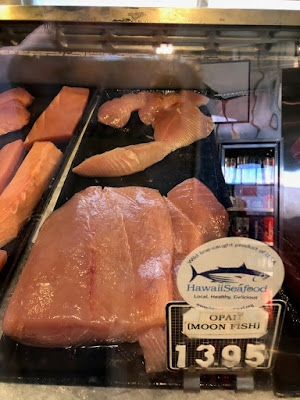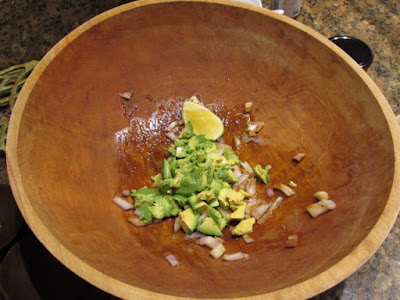View
from Nico’s restaurant at Pier 38
I love moon fish, or opah, as it is called in Hawaii. Moon fish is meaty and moist and comes out well any way you cook it. I like to bake it, either in fillets for smaller servings or in one large piece for a group, which was how I cooked it for a post-squid-research-cruise party when I lived in Kailua. For 18 years, my husband was part of a cooperative University of Hawaii / Hokkaido University research project that included January-February expeditions aboard a Japanese fisheries training vessel in Hawaiian waters. The year of the moon fish we’d recently moved upstairs into our newly built 600-foot tree-house apartment. We hadn’t yet rented out the downstairs of the house and still had use of its big gas oven, which I needed to cook the seven-pound piece of moon fish for the party. I planned to serve Thai beef salad, steamed rice, the usual guacamole and chips, roasted almonds, crudités, and olives as well, and hoped the moon fish would pull everything together for a casual buffet for 20 people.
First, I slathered the fish with olive oil. Then I dusted it with paprika, cumin, and salt and layered sliced limes across the top. I wrapped the whole thing in foil, put it a roasting pan, and baked it at 375 degrees for 45 minutes. (It probably would’ve taken less time if I hadn't opened the oven door every 15 minutes to check on it). The party was fun, despite standing-room-only space. Everyone enjoyed the moon fish. The captain said it was “sweet and delicious,” while the young ship’s officer, who spoke no English, showed his enthusiasm by joyfully opening a beer bottle with his teeth.
Moon fish is a wonderful main
course for a party, but these days I make it more often for just my husband and
myself. I buy fillets from Nico’s at Pier 38, a wonderful restaurant
/ fish market at the ship docks off Nimitz Highway. Here’s a partial look at what
was for sale there the day of my last purchase (recipe follows):
For two people you need: one
pound of moon fish (in two half-pound fillets or one whole piece), two
tablespoons of olive, one-half to one teaspoon each salt, paprika, and cumin,
one or two thinly sliced limes, and (optional) a few tablespoons of chopped
cilantro.
Coat the fish in with the
olive oil and put it in a shallow baking dish. Sprinkle it with salt, paprika,
and cumin. Layer the lime slices across the top (squeeze some lime juice over it too if you feel like it) and scatter the optional
cilantro over all. Let the fish rest at room temperature for 30 minutes to an
hour, then bake it uncovered in a preheated 375-degree oven for 15 to 20 minutes. You can
serve almost anything on the side--broccoli, asparagus, green salad, mashed potatoes, rice,
whatever you want. Below are a couple photos showing the last moon fish I cooked. (Note: I only wrap the fish in foil if it's a large piece, like the seven-pound portion for the party above. Also, salmon is wonderful cooked the same way.)
Here’s the moon fish fillet before
baking:
And being served with
rice salad and cherry tomatoes:
I hope you find this recipe sweet
and delicious too! Please use a bottle opener for the beer!













